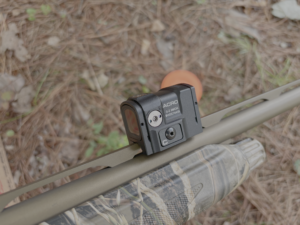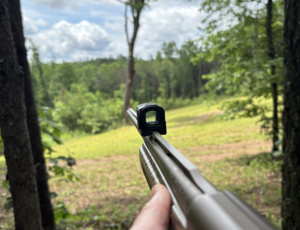When Is A Red Dot Right for Wingshooting?
Aimpoint’s ACRO S-2 Is A Rib-Mounted Shotgun Sight
You’re probably familiar with Aimpoint from their home-defense handgun red dots. They’re known to be durable and are built to tight tolerances.
Aimpoint also makes red dots and tube scopes with illuminated reticles for deer hunting and hog hunting for longer-distance shots. The Micro H-2 is likely the most famous: 2 MOA dot, 3.3 ounces and easy to mount. It’s the go-to sight for dropping running boars in Europe.
The U.S. Army adopted Aimpoint’s M68 CCO sights in 1997 for close combat duty. That sure says something about durability.
But what about a red dot for dove, upland bird, waterfowl or even clay shooting? Is an Aimpoint ACRO S-2 right for your wingshooting?
Maybe.
Aimpoint recently released the ACRO S-2 ($755). The 2.6-ounce, enclosed red dot mounts onto pretty much any ventilated-rib shotgun, whether Perazzi or Mossberg and about everything in between. The sight comes with several different mounting plates to fit ribs from 6-12mm.

Aimpoint knows how to build red dots. The ACRO S-2 is made for hunting, but its pedigree is military. ACRO stands for Advanced Combat Reflex Optic. You know it’s built tough.
The idea is when you’re swinging a shotgun, the traditional wisdom is to mount the gun the same way every time, both eyes open, with the muzzle out in front of the target. You pick up the target with your eyes, track it — not the bead, or the barrel or a dot — and squeeze the trigger.
That method has served wingshooters well for years. But not everyone, always.
If you are cross-eye dominant, that is, you are a righty, but your left eye is the eye you mainly focus with, or you are a lefty and your right eye is dominant, this sight is your salvation.
Shooters with this affliction can find relief with the ACRO S-2. The scope has no magnification, so you can keep both eyes open. It’s also parallax free, so if you don’t get that perfect cheekweld, it’s likely you’ll be on target anyway. No matter where you hold the gun, no matter which eye is dominant, if the dot is on target, the shot is on target.
Problem solved.
Longtime shotgunners, who have honed their craft and consistently powder clay targets or limit out on speedy doves in no time, probably aren’t interested in changing the way they shoot a shotgun.
But for anyone who needs a change or needs a reference point, a red dot floating above the barrel is a yeoman’s option.
That’s why the S-2 red dot is a lot larger — 9 MOA — than your everyday dot like the 2 MOA dot you probably have in your Micro H-2. A larger dot helps you be aware of it yet not focus on it.
There are also 10 intensity settings on the S-2, which is perfect for changing from early low-light conditions through noon and then through evening shooting. Backgrounds also change, so it’s good to have those brightness options at your fingertips.
We took the ACRO S-2 to the clays course at Garland Mountain in Waleska, Georgia, and to a patterning board to see how it performed.
We used a common shotgun, a Stoeger 3020, and found that the parts marked B and 2 worked just right. It’s a good idea to use calipers to determine the width of the rail and then the thickness of the rail. Then check the directions, which will tell you which included rail mount to use.

The Aimpoint ACRO S-2 can be mounted on any shotgun’s ventilated rib. For new shooters and for cross-dominant shooters, this is might help them break more clays or drop more gamebirds.
At the patterning board, we bore-sighted, then put the gun on a rest at 20 yards and confirmed with three shots of 7 ½ shot that it was shooting high and right. We adjusted the S-2 with a small flathead screwdriver and shot three more times, walking the center mass to the point of aim.
At the range, it was a very different way to shoot clays for me. Personally, I subscribe to the Gil Ash method of watching only the moving clay and mounting with the barrel out in front of the moving object. This works very well for me, and I’ve been shooting since I was 14.
With the sight on the gun, I had to change my style completely. I could see how some people, especially new shooters, would appreciate the ACRO as a starting point. If they use the dot as a reference, not as an aiming point or front bead, then it could help their understanding of the relationship between the moving target and where the muzzle is pointing.
Whether you mount this on your swinging shotgun or not, this site is excellent for the more traditional hills-and-hollers hog hunting, turkey hunting and tight-quarters coyote hunting with a scattergun, like we do here in the Southeast.
The ACRO S-2 is a versatile sight with a clever mounting system. As far as wingshooting, it’s not for everyone, but it might be the perfect solution for some.

